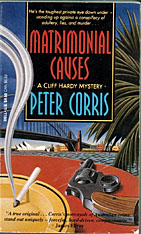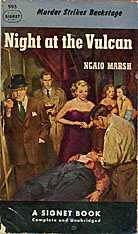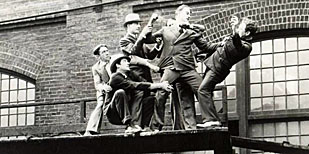REVIEWED BY DAVID VINEYARD:

SIMON RAVEN – The Sabre Squadron. Anthony Blond, UK, hardcover, 1966. Harper & Row, US, 1967. Reprinted several times, including Panther, UK, paperback, 1967; Beaufort, US, hardcover, 1987.
It was said of Simon Raven “he had the mind of a cad but the pen of an angel,” a statement that explains why much of his work has the wicked appeal of really juicy gossip; nasty, bawdy, cruel, but impossible not to listen to. If you can imagine Christopher Hitchens rudely crossed with Kingsley Amis and Gore Vidal you at least approach Raven’s unique voice.
In the period following the Second World War he produced a series of ten novels known as the Alms for Oblivion sequence that have been compared to Anthony Powell, C.P. Snow, and Evelyn Waugh, and yet have their own wicked glories. Many of these books and his other works touch on elements of crime, suspense, intrigue, and murder, and The Sabre Squadron, from the Alms sequence is a glimpse at the icy hell beneath the glamour of the world of James Bond:
The Sabre Squadron follows the fate of Daniel Mond, a mathematician in post-war England sent to Gottingen in Germany in 1952 to work on the Dortmund papers, the work of a brilliant mathematician whose work was ignored by the Nazis in favor of their atomic and rocket research, but which now has been found to have some value. “…it’s hard to see why he behaved as he did (Daniel writes of a colleague’s reaction to learning Daniel will be working on the Dortmund Papers); he went on at me as if I were practicing Black Magic or hunting for the Philosopher’s Stone.”

From the beginning Mond finds that there is more to Dortmund’s work than he might suppose:
… for weeks now there had been something —he could not quite say what — something sly, something treacherous about the behavior of the symbols and series to which he would shortly return; that there was something which included his loneliness and the threat posed by his symbols and yet transcended these, something which, as he sat warm and well fed on the sunny terrace above Gottingen, seemed suddenly to settle about him like air from a tomb.
Mond, a British Jew, has been a lonely scholarly type for most of his life, but shortly he will find himself adopted by the officers of the 49th, Earl Hamilton’s Light Dragoons with whom he is barracked, among them the charming Major Fielding Grey, the hero of the first novel in the Alms sequence, and recurring character in all ten books and the late First Born of Egypt series, a bi-sexual hedonist who frequently leaves chaos and charm in his wake.
But Mond finds nothing but good will and amusement among the Dragoons, the first real fellowship and feeling of belonging in his life. And he finds he needs it now more than ever because there is something dangerous about the work Dortmund has done; sinister and deadly secrets:

“Nature’s stability could be infiltrated, it’s basic and binding nature corrupted. There would not be bigger and better explosions … there would be dissolution.”
Eventually Mond enlists his new friends to smuggle him out of Germany to escape the implications of his work, a nightmarish farce that nearly ends in his death. Mond is about to discover some unhappy truths and be left with only one choice if he is to be true to his new friendships, his honor, and the God he doesn’t believe in.
At his best, Raven has the ability to be wonderfully vulgar without ever descending to the mere common, equally at home in a boardroom or a brothel, and equally observant of the social mores of both, observing with a scalpel like eye in as chilly a novel of international intrigue as you will ever read.
Raven wrote at least one mystery (The Feathers of Death), a spy novel (Brother Cain), and several horror novels (Doctor Scarlett or Incense for the Damned, and September Castle). His work is wicked and amusing, shocking, and unsparing of anyone. In his later years he had another career as a memoirist and travel writer revealing how much of his Fielding Grey was biographical — at least in his nature. Here he reveals a glimpse of hell that you will never forget. He is a most remarkable writer, for the razor wrapped in velvet nature of his prose, and the revelations in his work of himself and his society..



